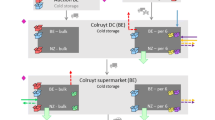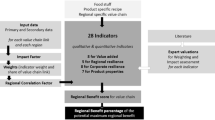Abstract
Background, Aims and Scope
Over the last five decades, the nature of food retailing has undergone an enormous transformation. Macro level economic, structural and technological developments have led to a major increase in the level of world trade. These developments have helped retailers to meet modern consumer expectations, but benefits have not been achieved without some drawbacks. This paper seeks to explore the environmental impacts associated with fresh produce supply chains, in order to understand the relative significance of transport as compared to other supply chain activities.
Methods
Life Cycle Assessment was used to estimate the potential environmental impacts of three fresh produce items sourced from six countries and solid in Marks and Spencer stores: royal gala apples from Brazil, Chile, Italy and the UK; runner beans from Kenya (and extrapolated for Guatemala and the UK); and watercress from the UK and USA (and extrapolated for Portugal). Analysis was also conducted to evaluate the likely impacts of extending the storage period for UK apples thus negating the need to import, against the current strategy of importing fruit from the Southern hemisphere for six months of the year. In addition, the impacts of conventional as compared to organic cultivation were considered for watercress in both the UK and USA.
Results and Discussion
The results for all three products reveal similar dominating impacts. A clear distinction arises in terms of the activities which contribute most to environmental impact and the magnitude of this impact, depending on the country in which the product is cultivated; i.e. global, regional (European) or local (British) sources of supply.
Conclusion
Transport (or distance between production and consumption) is therefore an important factor in determining the environmental sustainability of food supply chains (though for long distance haulage, there is a significant distinction between air-freight and shipping). Electricity consumed for storage and packing operations is also significant, and the associated environmental impact is lower in countries where a large proportion of electricity is generated from renewable fuels. However, where this occurs in countries distant from the UK, transport impacts overshadow the environmental savings achieved from the more favourable electricity generation mix.
Recommendations and Perspectives
The results of this study suggest that when in season it is generally preferential, on environmental grounds, for UK consumers to buy British produce rather than produce imported from overseas. Cultivation overseas is necessary to ensure year-round availability and in these circumstances it is preferable that processing activities also occur overseas if environmental benefits can be derived from local factors (e.g. a favourable electricity generation mix). Overall, the findings should be evaluated in the context of managing wider sustainability interests (including social and economic issues), for which further research is required.
Similar content being viewed by others
References
Cowell S, Parkinson S (2003): Localization of UK food production: An analysis using land area and energy as indicators. Ecosystems and Environment 94, 221–236
Seaton L (2002): Fresh produce desk book 2002. Fresh Produce Journal, London
Jones A (1999): The environmental impacts of distributing consumer goods: A case study on dessert apples. PhD Thesis, Centre for Environmental Strategy, School of Engineering in the Environment, University of Surrey, Guilford
Jones A (2001): Eating Oil — Food in a changing climate. Sustain & Elm Farm Research Centre, London
Millstone E, Lang T (2003): The atlas of food: Who eats what, where and why. Earthscan, London
Garnett T (2003): Wise Moves: Exploring the relationship between food, transport and CO2. Transport 2000
DEFRA (2000): Climate change, the UK programme
DETR (1998): UK Air Freight Study Report. Department for the Environment, Transport and the Regions
Watkiss P, Smith A, Tweddle G, McKinnon A, Browne M, Hunt A, Treleven C, Nash C, Cross S (2005): The Validity of food miles as an indicator of sustainable development. Final Report for DEFRA 2005
Jungbluth N, Demmeler M (2004): Letters to the Editor: ‘The Ecology of Scale: Assessment of Regional Energy Turnover and Comparison with Global Food’ by Elmar Schlich and Ulla Fleissner. Int J LCA 10(3) 168–170
Andersson K, Ohlsson T, Olsson P (1998): Screening life cycle assessment (LCA) of tomato ketchup: A case study. J Cleaner Prod 6, 277–288
Berlin J, Tillman AM, Nybrandt T, Sonesson U (2001): Life Cycle Assessment of Cheese. Proceedings of the International Conference on LCA in Foods, Gothenburg, Sweden, 26–27 April
de Boer IJM (2003): Environmental impact assessment of conventional and organic milk production. Livestock Production Science 80, 67–77
Mila i Canals L (2003): Contributions to LCA methodology for agricultural systems. Site dependency and soil degradation impact assessment. Universitat Autonoma de Barcelona, Spain
Sundkvist A, Jansson A, Larsson P (2001): Strengths and limitations of localizing food production as a sustainability-building strategy — An analysis of bread production on the island of Gotland, Sweden. Ecological Economics 37, 217–227
Stadig M (1997): Life cycle assessment of apple production: Case studies for Sweden, New Zealand and France. SIK Report No. 630, p 117, Gothenburg, Sweden (in Swedish, summary in English)
Schilch EH, Fleissner U (2004): The Ecology of Scale: Assessment of Regional Energy Turnover and Comparison with Global Food. Int J LCA 10(3) 219–223
Blanke M, Burdick B (2005): Food (miles) for thought. Environ Sci Pollut Res 12(3) 125–127
Dolan C, Humphrey J, Harris-Pascal C (1999): Horticulture commodity chains: the impact of the UK market on the African fresh vegetable industry. IDS Working Paper 96
Andersson K, Ohlsson T, Olsson P (1994): Life Cycle Assessment (LCA) of food products and product systems. Trends in Food Science and Technology 5, 134–138
Cowell SJ, Clift R (2000): A Methodology for Assessing Soil Quantity and Quality in LCA. Journal of Cleaner Production 8, 321–331
Cowell S (1998): Environmental Life Cycle Assessment of agricultural systems: Integration into decision making. PhD Thesis, Centre for Environmental Strategy, University of Surrey, Guildford. Chapter VI — An LCA Study of bread making wheat production
Audsley E, Brentrup F, Cederberg C, Cowell S, Gaillard G, Goldhan G, McKeown P, Jolliet O, Lindeijer E, Satter I (1997): Theme report methodology working Group LCAnet Food
Nemecek T, Hei A, Huguenin O, Meier S, Erzinger S, Blaser S, Dux D, Zimmermann A (2003): Life Cycle Inventories of Agricultural Production Systems. Final Report ecoinvent 2000, Vol 15, Swiss Centre for LCI, FAL & FAT, Dubendorf, Switzerland
Baumann H, Tillman AM (2004): The hitch hiker’s guide to LCA — An orientation in the life cycle assessment methodology and application. Studenttilleratur, Sweden
Weidema B (2001): Avoiding Co-Product Allocation in Life cycle Assessment. Journal of Industrial Ecology 4(3) 11–33
BUWAL 250 (1996): Ökoinventare für Verpackungen. Schriftenreihe Umwelt 250, Bern
Energy Information Administration — Official Energy Statistics from the US government. Available at 〈www.eia.doe.gov〉
WWF conference (2003): 〈www.panda.org/downloads/europe/presentationmcoggiatti.pdf〉
Mbogho, Zhu & Sharma (date unknown): Meeting energy needs: The Kenyan scenario. Available at 〈 http://www.itee.uq.edu.au/:_aupec/aupec03/papers/039%20Mbogho%20full%20paper.pdf 〉
Green (1987): In: Audsley E, Brentrup F, Cederberg C, Cowell S, Gaillard G, Goldhan G, McKeown P, Jolliet O, Lindeijer E, Satter I (1997): Theme report methodology working Group LCAnet Food
Royal Commission on Environmental Pollution (2005): Pesticides and Bystander Exposure, Special Report
Davis J, Haglund C (1999): Life Cycle Inventory (LCI) of fertiliser production. Fertiliser products used in Sweden and Western Europe. SIK Report No 654, Chalmers University of Technology
Brady NC, Weil RR (1996): The Nature and Properties of Soils. Prentice-Hall Inc., New Jersey
Royal Commission on Environmental Pollution (2002): The environmental effects of civil aircraft in flight — Special report. Royal Commission on Environmental Pollution
IEIA (2000): 〈www.eia.doe.gov/emeu/world/country/cntry GT.html〉
IEIA (1999): In: Bosi M (2000): International Energy Agency (IEA) Information Paper: An initial view on methodologies for emission baselines: electricity
Eco-indicator email discussion forum (2003)
PRE Consultants, Eco-indicator email discussion forum (2003)
Personal Communication with M&S apple technologist (2004)
Wright E, Cowell S (2002): Energy analysis of importing cut flowers into the UK: A report for Marks and Spencer
Author information
Authors and Affiliations
Corresponding author
Rights and permissions
About this article
Cite this article
Sim, S., Barry, M., Clift, R. et al. The relative importance of transport in determining an appropriate sustainability strategy for food sourcing. Int J Life Cycle Assess 12, 422–431 (2007). https://doi.org/10.1065/lca2006.07.259
Received:
Accepted:
Published:
Issue Date:
DOI: https://doi.org/10.1065/lca2006.07.259




